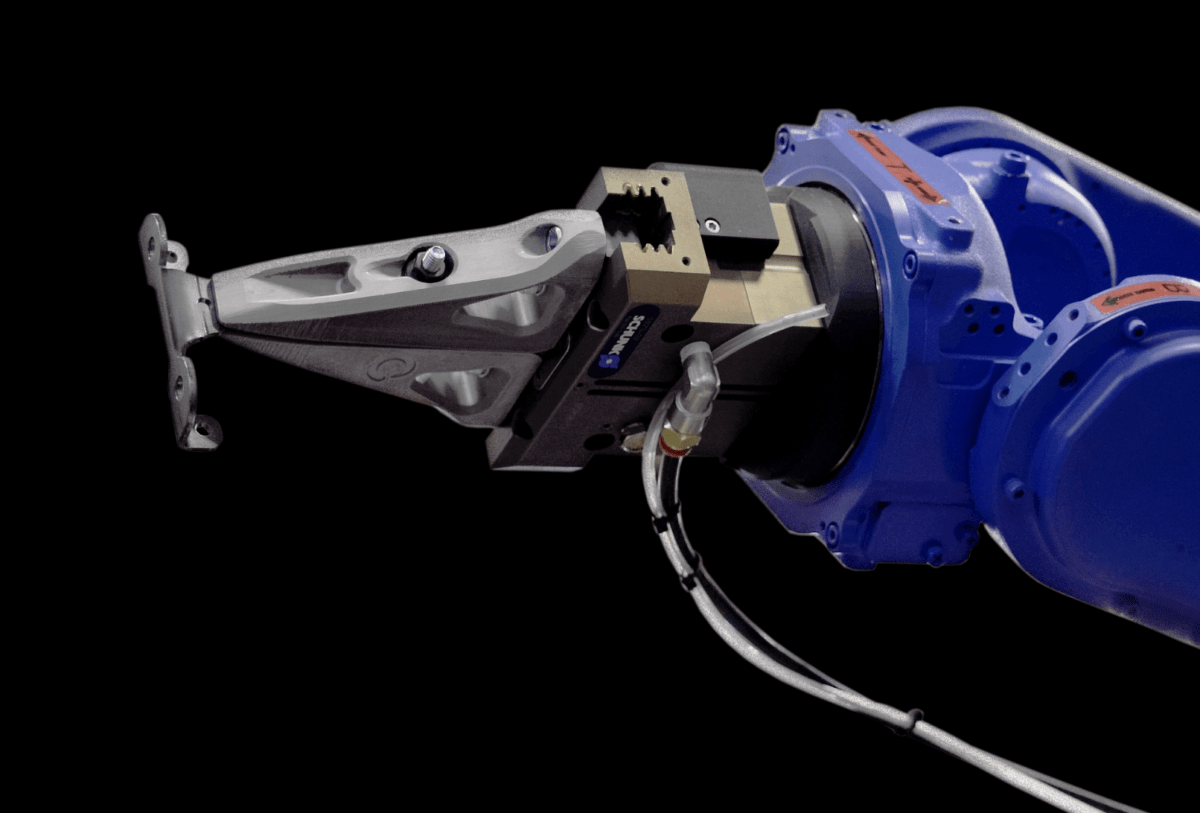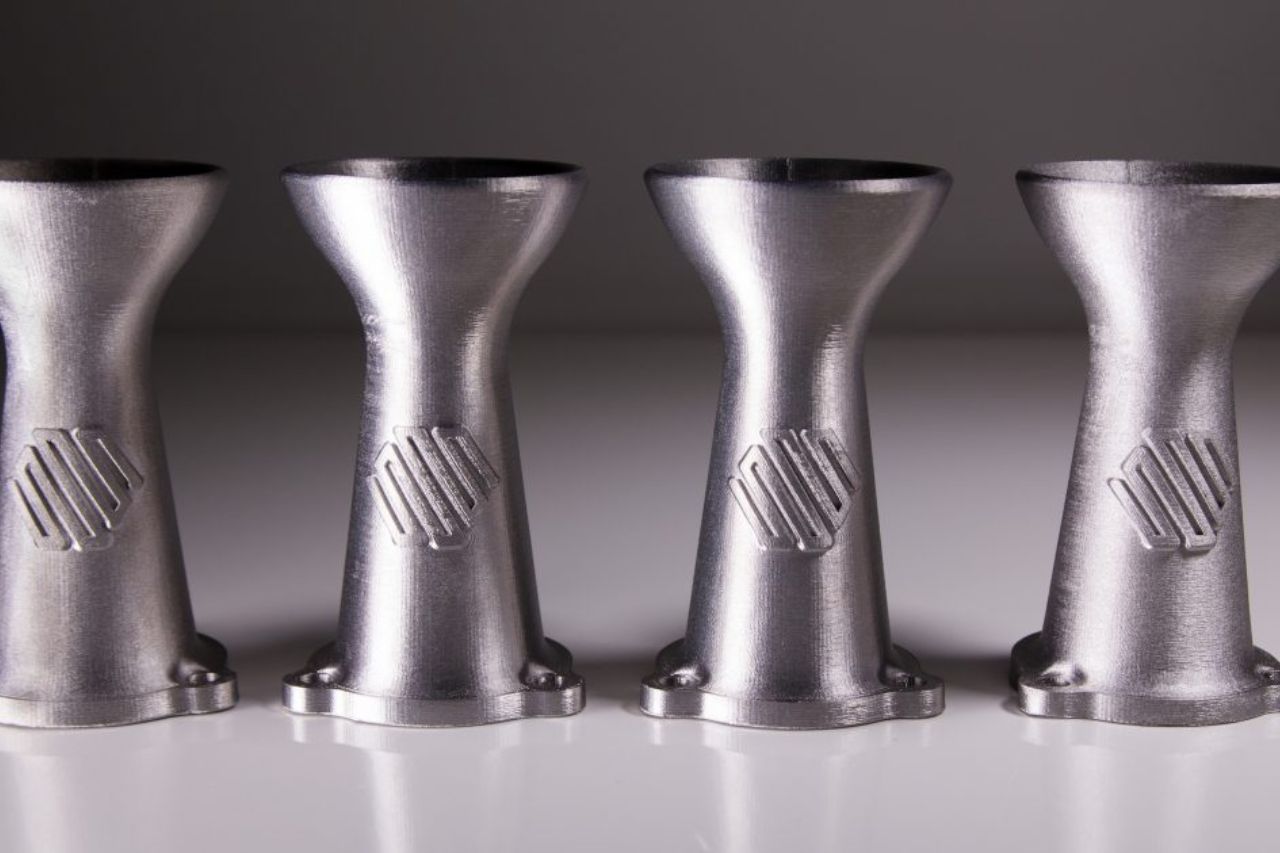Metal 3D printing is changing the way industries across every horizon create parts. It allows for tooling, fixtures, and end-use parts to be made more quickly, precisely, and cheaper than ever before – even for complex and intricate parts. This technology combines the design flexibility of 3D printing with the mechanical properties of metal. From tooling inserts with cooling channels to lightweight structures for aerospace, any application that involves complex metal parts potentially benefits from metal 3D printing.
The metal 3D printing process involves sintering or melting metal powders directly, or combining them with a second material to allow delivery through a nozzle. This makes metal 3D printing a great fit for both rapid prototyping and finished production parts for aerospace, mechanical engineering, tooling and more.

Metal 3D printing made these gripper jaws more effective on the production line.
This set of gripper jaws, for example, moves pieces of sheet metal to and from a press brake. These jaws were 3D printed in metal, and solve three problems for the shop that uses them:
- The gripper jaws are printed using 17-4 PH Stainless Steel, which has high-abrasion resistance. This means the jaws won’t wear down from repeated contact with the steel sheet metal parts.
- The closed-cell infill within the part makes it much lighter than a traditional steel part, meaning the arm can move faster than with a machined equivalent and output a higher yield.
- The tips of the jaws are shaped and low-profile to avoid the press brake tooling but are designed to grip the part securely. This would have been difficult and expensive to machine out of the same material, so they decided to print the complex geometry instead.
The Metal X can solve a lot of problems when it comes to manufacturing, and you can see more of these solutions on our Applications page. Many of these examples stem from three core benefits of additive manufacturing, and how they can help cut down your cost per part:
Benefits of Metal Additive Manufacturing
The manufacturing sector is becoming more inventive, adaptive, and inquisitive than ever before with the use of 3D printers. Metal 3D printing has more benefits over traditional manufacturing technology, allowing:
- To work on complex designs
Complexity and optimization come at a cost for most traditional manufacturing processes — additional features mean more operations, longer machining time, or multi-part molds. These all heavily consume both material and your machinists’ time. Additive manufacturing removes many of these constraints. The process builds material layer by layer rather than cutting out of a bulk solid figure. Therefore, the material is placed only where it is needed, and the cost of the primary material used to produce one component is reduced. You consume less material and time by doing so.
- Full Automation
Metal 3D printers require minimal designated operator time. The printer’s software automatically generates toolpaths based on configurable settings, so no specialized manufacturing knowledge is needed to work with a given material — the machine handles all of that based on your selections. Moreover, you have total control over the object that will be manufactured. Once you kick off a print, it can operate without supervision, so you can maximize machine uptime by letting the printer run during non-working hours.
- Minimal Tooling or Setup
When making a part with traditional methods like milling, turning, or molding, some amount of effort and time needs to be spent on non-revenue generating parts. These are parts that support the manufacturing of the final part, including custom tooling, work holding, or molds. Metal 3D printers can create parts without extra manufacturing work or machine setup — all you have to do is press print to get the machine started!
Metal Additive Manufacturing
In this white paper, we show how you can use metal additive manufacturing to solve three challenges relevant to many industries.
What Challenges Does Additive Manufacturing Solve?
From these three benefits, we can derive many different applications in a variety of industries. The key to discovering the high-impact parts is understanding how they can impact you and your business’s bottom line. Where do you face challenges that impact yield? What is the cost of these inefficiencies? When metal 3D printed parts increase or maintain part performance with lower effort, cost, or time, they are valuable.
- Simplified Assemblies
Metal additive manufacturing encourages part consolidation with more geometric freedom for complex geometries. Consolidate parts that have been split into multiple segments because of manufacturing design constraints.
- Optimized Geometries
The design space for additive manufacturing is far different from traditional manufacturing processes, so you can consider how much material you’re adding to your part, rather than what you’re taking away. Save weight on critical components by adding material only where it is needed to make your part perform.
- Digital inventory and Legacy Parts
Using metal 3D printers and a cloud-based fleet management system, you can design and manufacture parts wherever there is a printer. Manage your inventory without warehouses full of spares by printing replacement parts onsite and on demand.
Download the Free Report on How COVID-19 has Impacted Supply Chains
Gain key insights including: COVID-19 pandemic impact on business. 3D printing use during the health pandemic. Challenges facing manufacturers using incumbent technology. Future plans for investing in additive manufacturing. And more...
Get the report